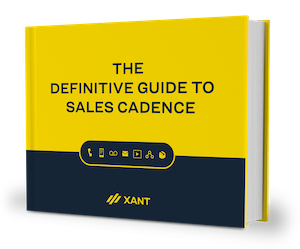The Definitive Guide to Sales Cadence
When sales reps reach out to prospects via email, phone or using social media, they execute what is called a sales cadence… That is, if they simply don’t give up after one phone call or email. Research shows you have a higher chance of contacting leads when you are persistent in your outreach. However, the data also shows that increasingly, sales reps give up too soon on leads.
A Guide to Build a Winning Sales Cadence
Gabe Larsen, vice president of XANT Labs, has put together the complete, definitive guide to building a sales cadence guaranteed to win sales. You can download the sales cadence guide to see how you can time your outreach attempts to make sure your leads respond.
When executed correctly, a sales cadence has a chance to nearly double your contact rates, according to XANT experiments (preliminary data from upcoming research).
The Five Keys to Sales Cadence Structure
The art of a cadence is determined based on a myriad of factors, but it’s fueled primarily by sales reps’ intuition. Here are the five key elements of a sales cadence:
- Attempts: The total number of touch points made
- Media: The type of communication methods used
- Duration: The time between the first and last attempt
- Spacing: The time gap between contact attempts
- Content: The messaging used
The eBook dives into all the elements that compose a sales cadence, and shows best practices for each, including tips and tricks to use with each communication media. Ever wondered what’s the ideal length for an email? How about a voicemail? Or how should you use text messages and social media into your sales strategy?
The Data-Driven Approach to Sales
Going with just your gut when figuring out how to contact prospects is not a great way to do sales. You’ll end up missing out on opportunities, or sometimes ticking off prospects by contacting them too much. The data-drive approach to sales allows you to learn from best practices from thousands of other companies, and create a sales cadence that works for your business environment.
The typical sales cadence, (the fundamental, so to speak) has an average of 3 touches, however there’s no one size fits all. Depending on the type of product or service you have, how your market is structured and how your sales team functions, you will need a different type of sales cadence. For example:
- Reps who follow up on inbound leads should focus more on aggressive methods such as the phone. This is especially if this is a transactional sale where deals are smaller and sales cycles are faster.
- Reps who go outbound to target contacts and accounts should start with more passive communication such as email or social, followed by more aggressive communication like the phone. This is especially true if this is a relational sale where deals are larger and sales cycles are slower.
The book focuses on results from research which includes over 14,000+ cadences, made up of 144,000+ total activities, across nearly 9,000 companies. The insights from this research is all peppered through the eBook, allowing you to draw conclusions which will lead to a winning sales cadence for your business.
Download the Guide to Sales Cadence
Download the “Definitive Guide to Sales Cadence” to learn:
- How many times you should attempt contact with prospects
- How long you need to wait between attempts
- What methods and messaging are most likely to result in a sale
- Strategies for phone call, voicemail, email and text messaging selling
- A bullet-proof strategy to create a sales cadence that works for your company and your sales model
This eBook includes free sales cadence templates to make your outreach cadence successful, best practices and a way to score your cadence to see how you’re doing compared to other sales professionals.

